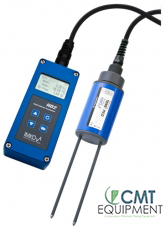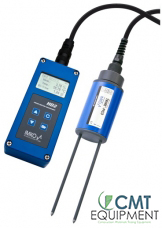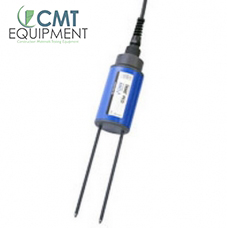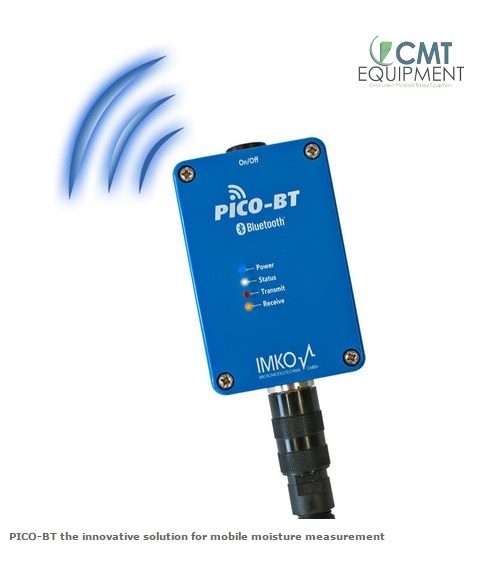HD2 Moibile Moisture Meter for Soils
Description
HD2 Moibile Moisture Meter for Soil
The IMKO HD2 - measuring the soil moisture content, the soil conductivity EC, and the level of salt contamination can now be performed as fast and easy as never before!
Within two seconds, the moisture content value, the temperature, and the soil conductivity EC are displayed on the clear display. The probe TRIME-PICO64 measures with the new TRIME®-radar technology (Time-Domain-Reflectometry).
- All of the TRIME-PICO probes can be connected to the HD2: TRIME-PICO 64, TRIME-PICO 32 und TRIME-PICO IPH T3/44.
- The TRIME-PICO probes can now report soil EC as standard simultaneously with soil moisture content percentage.
- The TRIME probes measure conductivity with the same large soil volume as it will be used for the TDR moisture measurement.
- Both durable and waterproof construction ensures safe handling even under difficutl environmental conditions.
A RELIABLE, PRACTICAL AND EASY-TO-USE DETERMINATION OF SOIL CONDUCTIVITY AND SALT CONTENT WITH TRIME PROBES: PICO 64, PICO 32 AND PICO IPH T3/44.
- TRIME probes measure conductivity with the same large soil volume as it will be used for the TDR moisture measurement. The contact of the probe rods inside the soil is far less critical as with "galvanic" EC probes with a point to point measurement where even small air gaps lead to significant deviations.
- - TRIME probes use coated and therefore isolated rods which guarantee the non-appearance of galvanic accumulation along the rods allowing for long-run installations over many years. Unisolated rods means there is a risk of galvanic reactions and possible influence on the sensor´s reading with serious problems when the probes must be removed from larger depths due to a rod cleaning.
- - TRIME probes measure moisture and conductivity very precisely at a frequency of 1GHz with a better and more exact separation of moisture and conductivity in comparison to capacitive probes with lower frequencies. This means that in practice, a reliable determination of the pore water conductivity ECw and respectively TDS (mg of salt per liter water) is possible at different moisture levels.
- All TRIME probes work with a concurrently basic calibration for moisture and conductivity. This allows a check of the limits of saline stress in soils according to standards of FAO2006 for specific soils.

THE ANALYSIS OF SOILS FOR ELECTRICAL CONDUCTIVITY ECTRIME
For agricultural and horticultural soils, the measurement of Electrical Conductivity is an immensely important measurement. Electrical Conductivity measures the amount of total dissolved salts (TDS) or total dissolved ions in water. To complicate matters, some ions such as Sodium and Chloride will contribute more to EC than others such as Phosphorus and Potassium.
Plants require nutrients such as Nitrogen, Phosphorus, Potassium, Magnesium in large quantities hence they are called major nutrients and also smaller amounts of elements such as Iron, Manganese , Molybdenum and these are called micro nutrients or sometimes referred to as trace metals. Fertilisers are supplied to plants as compounds for example Ammonium Nitrate which supplies Nitrogen in the form of Nitrate or Ammonium. Micro-organisms will break down these compounds so they are more readily available for uptake by the plants. Levels of some ions such as Chlorides are less desirable and in great quantities can be harmful to plant growth. The quantity of ions or salts in a soil is of huge importance. Too much or too few nutrients will create a restriction in plant growth.
IMKO has studied the subject in detail and has come up with a breakthrough. By using coated rods and measuring over the length of the probes, all TRIME probes can now accurately report what IMKO calls ECTRIME. This measurement takes account of soil moisture and conductivity by volume. Because soil moisture is so important in the calculation of EC, all different TRIME probes now incorporate TDR calibration curves for a selection of soils. Special graphs have been constructed so that the user can convert the ECTRIME reading to grams/litre of dissolved salt. So far curves are available for sandy and loam soils and it is intended to produce a handful of curves to cover most situations. At this moment in time, conversion of ECTRIME to mg/l TDS is done manually.
IMKO hopes that this breakthrough whereby a TDR instrument can be used to derive a true soil EC measurement will become the new standard for soil fertilisation analyses.




